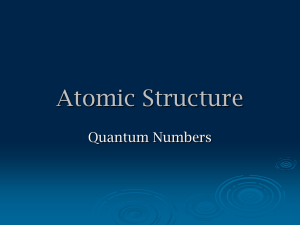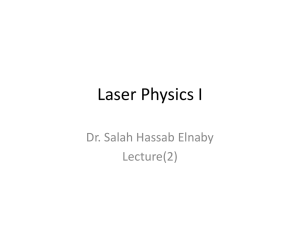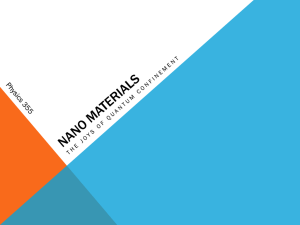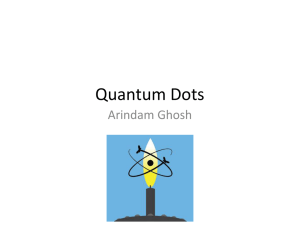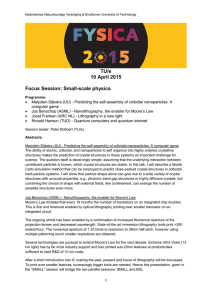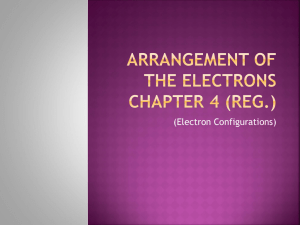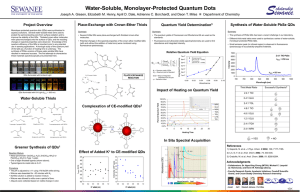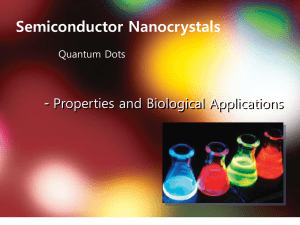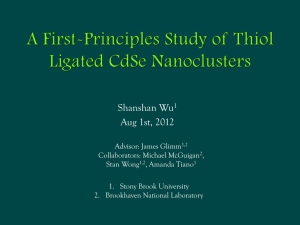Prezentacja programu PowerPoint
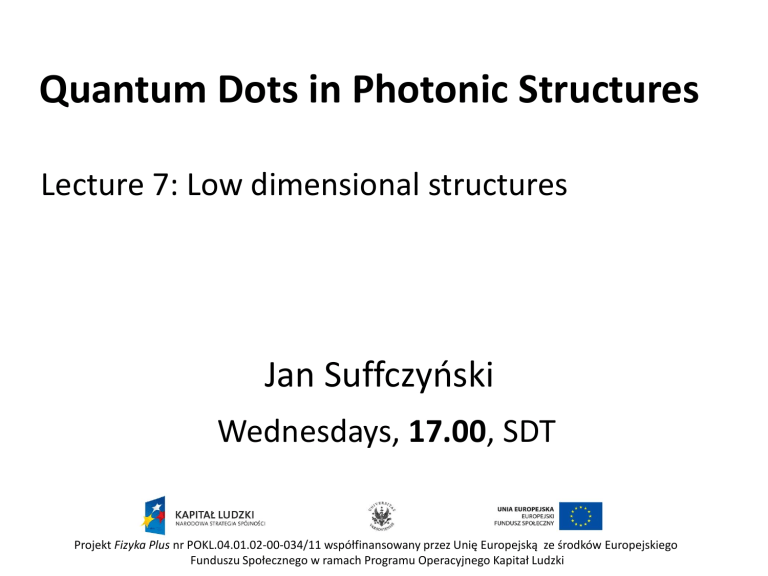
Quantum Dots in Photonic Structures
Lecture 7: Low dimensional structures
Jan Suffczyński
Wednesdays, 17.00, SDT
Projekt Fizyka Plus nr POKL.04.01.02-00-034/11 współfinansowany przez Unię Europejską ze środków Europejskiego
Funduszu Społecznego w ramach Programu Operacyjnego Kapitał Ludzki
Plan for today
1.
Reminder
2.
Doping and holes
3.
Low dimensional structures
Wigner-Seitz Cell construction
Form connection to all neighbors and span a plane normal to the connecting line at half distance
Bloch’s theorem:
Bloch waves
Solutions of the Schrodinger equation
2
2 m d
2 dr
2
ˆ
( r
)
Ψ k
( r
)
k
Ψ k
( r
) for the wave in periodic potential U(r) = U(r+R) are:
Bloch function:
k
( r
)
e i k r u k
( r
)
Envelope part
Periodic (unit cell) part u k
( r
)
u k
( r R
)
Felix Bloch
1905, Zürich -
1983, Zürich
Kittel
Nearly free electron model
Origin of a band gap!
Isolated Atoms
Diatomic Molecule
Four Closely Spaced Atoms
conduction band valence band
Band formation
Electronic energy bands
Brilluoin zones
k
2 k
2 m
2
(k): single parabola folded parabola
Electron velocity and effective mass in the k-space
2 k
2
2 m *
Electron velocity and effective mass in the k-space
2 k
2
2 m *
Velocity is zero at the top and bottom of energy band.
Electron velocity and effective mass in the k-space
2 k
2
2 m *
Velocity is zero at the top and bottom of energy band, the.
Efective mass: m*>0 at the band bottom, m*<0 at the band top, in the middle: m*→ ± ∞ (effective mass description fails here).
Doping of semiconductors
Holes
• Consider an insulator (or semiconductor) with a few electrons excited from the valence band into the conduction band
• Apply an electric field
– Now electrons in the valence band have some energy states into which they can move
– The movement is complicated since it involves ~ 10 23 electrons
Holes
• We can “replace” electrons at the top of the band which have “negative” mass (and travel in opposite to the “normal” direction) by positively charged particles with a positive mass, and consider all phenomena using such particles
• Such particles are called Holes
• Holes are usually heavier than electrons since they depict collective behavior of many electrons
Low-dimensional structures
Dimensionality
Increase of the dimension in one direction
2
2
2
Increase of the volume
1
2 1
2 2
2 2 3
Low-dimensional structures
B A B z quantum well
B A B z quantum wire
A z quantum dot
Discrete States
• Quantum confinement
discrete states
• Energy levels from solutions to Schrodinger Equation
• Schrodinger equation:
2
2 m
2
V ( r )
E
V
• For 1D infinite potential well
( x ) ~ sin( n
x
L
) , n
integer x=0
• If confinement in only 1D (x), in the other 2 directions
energy continuum
Total Energy
n
2 h
2
8 mL
2
p
2 y
2 m
p
2 z
2 m x=L
Quantum Wells
Energy of the first confined level
W. Tsang, E. Schubert, APL’1986
Decrease of the level energy when width of the
Quantum Well decreased
Quantum Wells
Energy of confined levels
GaAs/AlGaAs Quantum Well
R. Dingle,
Festkorperprobleme’1975
In 3D…
• For 3D infinite potential boxes
( x , y , z ) ~ sin( n
x
L x
) sin( m
y
) sin(
L y q
z
) , n,
L z m, q
integer
Energy levels
n
2 h
2
8 mL x
2
m
2 h
2
8 mL y
2
q
2 h
2
8 mL z
2
• Simple treatment considered
– Potential barrier is not an infinite box
• Spherical confinement, harmonic oscillator (quadratic) potential
– Only a single electron
• Multi-particle treatment
• Electrons and holes
– Effective mass mismatch at boundary
Density of states
DoS
dN dE
dN dk dk dE
N ( k )
k space vol vol per state
4
( 2
3
k
)
3
3
V
Structure
Bulk Material
Quantum Well
Quantum Wire
Quantum Dot
Degree of
Confinement
0D
1D
2D
3D dN dE
E
1
1/ E d (E)
Quantum Dots
QD as an artificial atom
QD as an artificial atom
Atom Quantum Dot
3D confinement of electrons
Discrete density of electron states
Emission spectrum composed of individual emission lines
Non-classical radiation statistics
(e. g. single photon emission)
Creation of „molecules” possible
QD as an artificial atom
- differences
Electron binding energy
Atom Quantum Dot
Size 0.1 nm 10 nm
Confining potential Coulombic (~1/r 2 ) Parabolic
10 eV 100 meV
Interaction of electron with environement
Weak Strong (phonons, charges, nuclear spins…)
Anisotropy of confining potential
No Yes (shape, compoistion, strain…)
QD size
• Should be small enough to see quantum effect
• k
B
T at 4.2 K ~0.36 meV --> for electron maximum dimension in 1D ~100-200 nm
(Energy levels must be sufficiently separated to remain distinguishable under broadening, e.g. thermal)
• Small size
larger energy level separation
QD types and fabrication methods
• Goal: to engineer potential energy barriers to confine electrons in 3 dimensions
• Basic types/methods
– Colloidal chemistry
– Electrostatic
– Lithography
– Epitaxy
• Fluctuation
• Self-organized
• Patterned growth
- „Defect” QDs
Colloidal Particles
• Engineer reactions to precipitate quantum dots from solutions or a host material (e.g. polymer)
• In some cases, need to “cap” the surface so the dot remains chemically stable (i.e. bond other molecules on the surface)
• Can form “core-shell” structures
• Typically group II-VI materials (e.g. CdS, CdSe)
• Size variations ( “size dispersion”)
Si nanocrystal, NREL
CdSe core with ZnS shell QDs
Red: bigger dots!
Blue: smaller dots!
Evident Technologies: http://www.evidenttech.com/products/core_shell_evidots/overview.php
Sample papers: Steigerwald et al. Surface derivation and isolation of semiconductor cluster molecules. J. Am. Chem. Soc., 1988.
Electrostatically defined QDs
• Only one type of particles (electron or holes) confined
--> (No spectroscopy)
Lithography defined QDs
• QW etching and overgrowth
QW
Etching
Verma/NIST
Overgrowth
• Mismatch of bandgaps
potential energy well
• The advantage: QD shaping and positioning
• The drawback: poor optical signal
(dislocations due to the etching!)
Lithography defined QDs
V. B. Verma et al., Opt. Express’2011
Lithography
• Etch pillars in quantum well heterostructures
– Quantum well heterostructures give 1D confinement
– Pillars provide confinement in the other 2 dimensions
• Disadvantages: Slow, contamination, low density, defect formation
A. Scherer and H.G. Craighead. Fabrication of small laterally patterned multiple quantum wells. Appl. Phys. Lett., Nov 1986.
Flucutation type QDs
Flucutation of QW thickness
Flucutation of QW composition
Epitaxy: Self-Organized Growth
Lattice-mismatch induced island growth
Self-organized QDs through epitaxial growth strains
– Stranski-Krastanov growth mode (use MBE, MOCVD)
• Islands formed on wetting layer due to lattice mismatch (size ~10s nm)
– Disadvantage: size and shape fluctuations, strain,
– Control island initiation
• Induce local strain, grow on dislocation, vary growth conditions, combine with patterning

